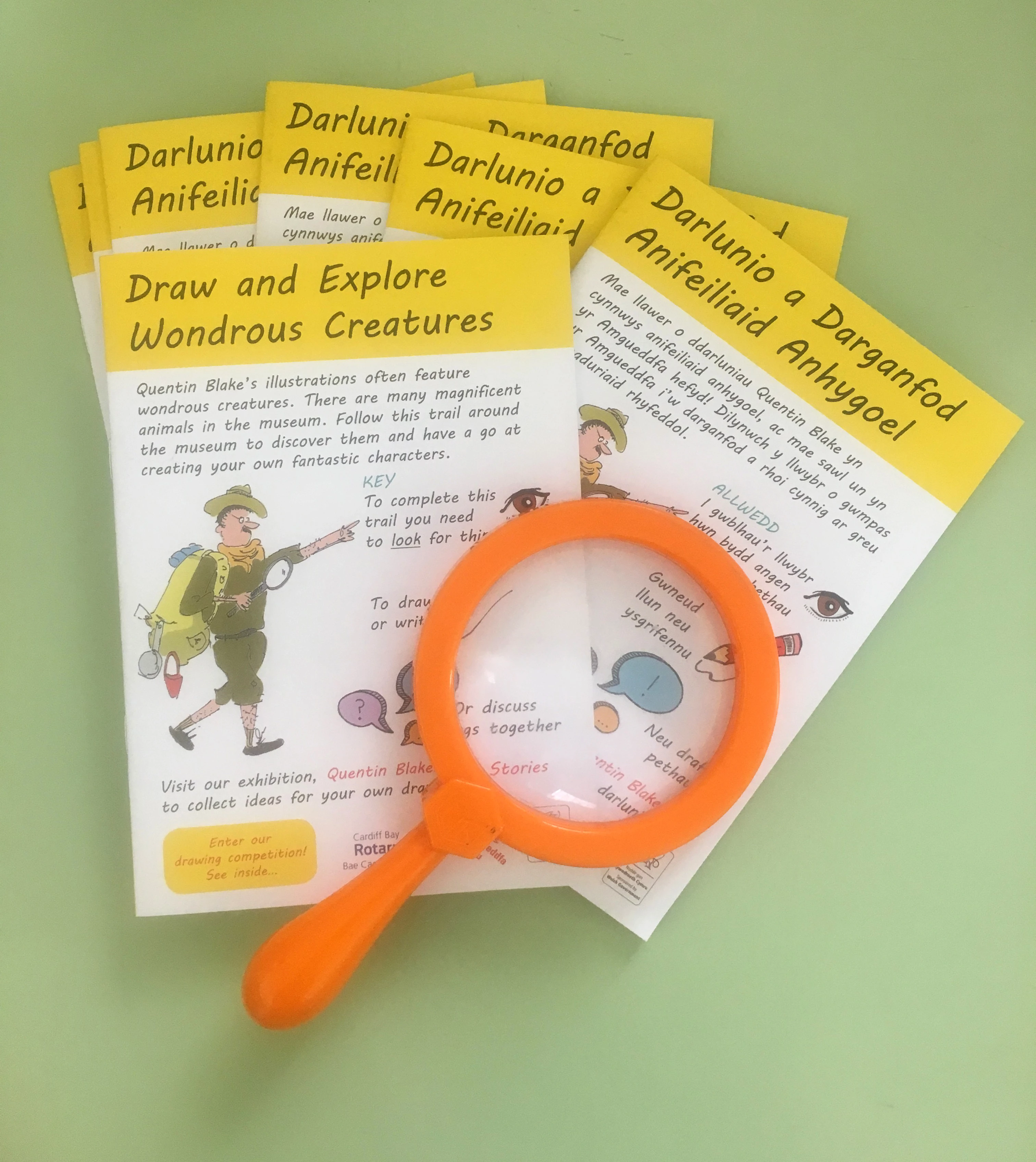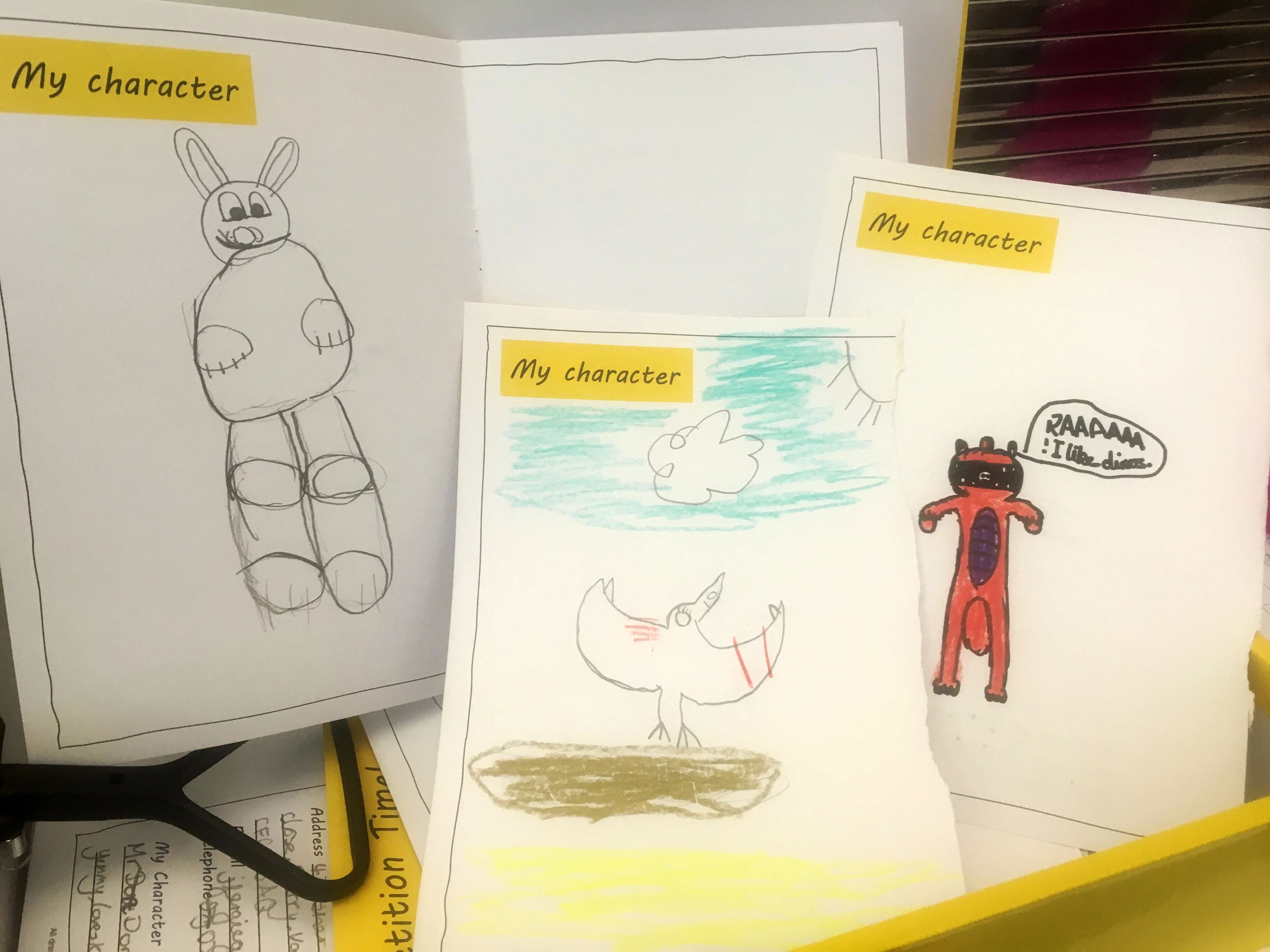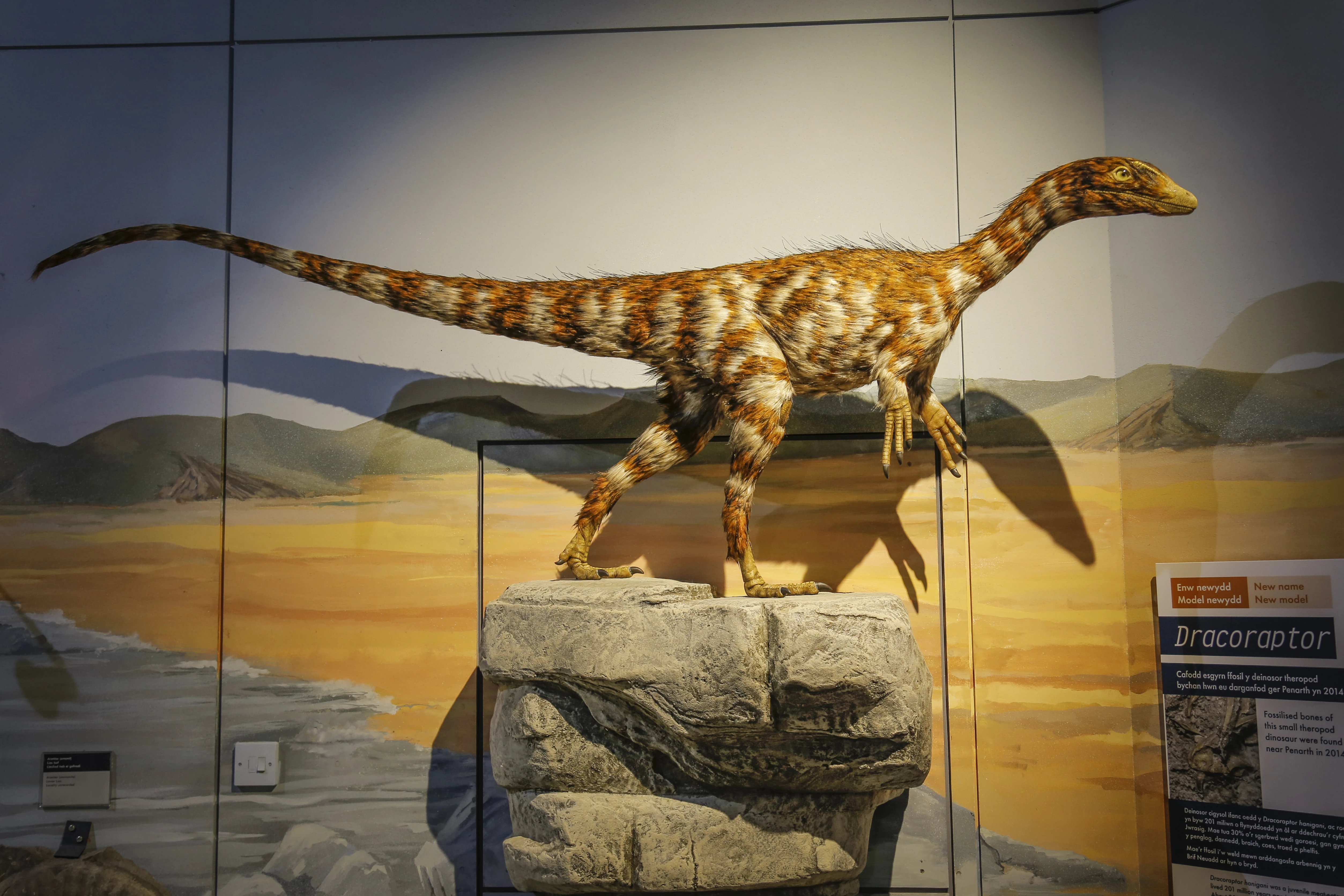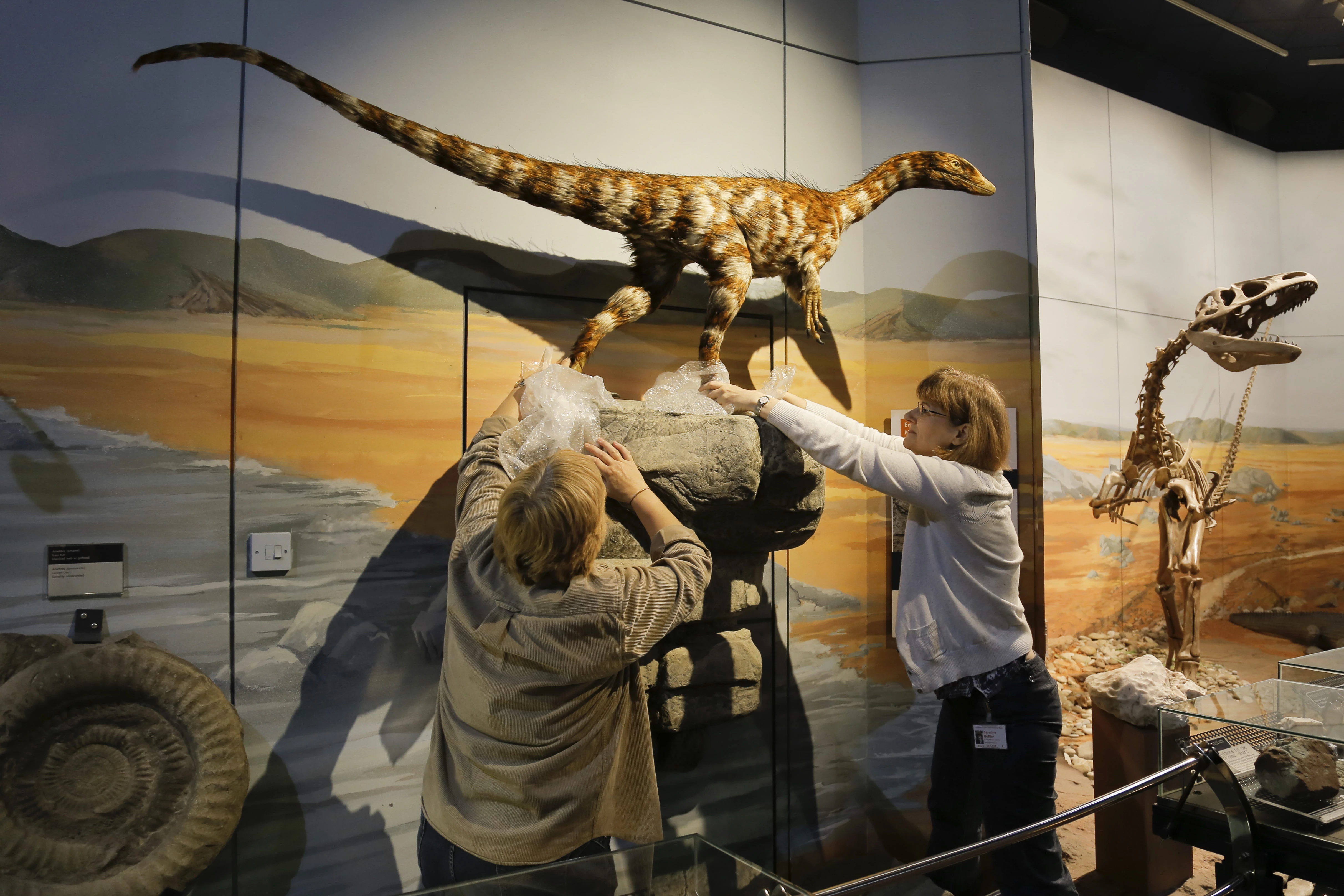The Museum's gone Quentin Blake and Roald Dahl Crazy!
, 5 Awst 2016
Since the launch of the Quentin Blake exhibition our inbox has been filling up, and the phone hasn’t stopped with fellow Roald Dahl and Quentin Blake superfans wanting to know more about what's going on. Everyone wants to get involved! So I thought I’d share a little bit of what’s been happening so far.
The Exhibition
People have been coming along to draw in the gallery and already our wall is bursting with wonderful drawings.
Want to join in? https://museum.wales/cardiff/whatson/8916/Quentin-Blake-Inside-Stories/
Activity Booklet
Our activity booklets have been flying out and the competition entries have been coming in thick and fast!
To draw your way around the museum and take part in the competition, just pop in to the Clore Discovery centre to get your very own booklet https://museum.wales/cardiff/clore/
Family Workshop
Families have been making some really nice little storybooks of their very own.
Teachers
We have a teacher's pack in both Welsh and English that will help you explore the exhibition with your class - https://museum.wales/media/38707/QB-FINAL.pdf
Cymraeg - https://amgueddfa.cymru/media/38708/QB-FINAL-cy.pdf
If you would like to bring your class to the museum all the information you need about booking is available at - https://museum.wales/cardiff/learning/booking_information/
A Window into the Industry Collections – July 2016
, 26 Gorffennaf 2016
As usual in this monthly blog post I’d like to share with you some of the objects that have recently been added to the industry and transport collections.
The first object this month is a photograph that shows the first ever rally of the Welsh Automobile Club. This was held at Bracelet Bay (a small bay close to Swansea near Mumbles Head) on 3rd December, probably in 1906 though we are not sure of the year. Can anyone help? The photograph was taken by W. Richards (late W.C. Roberts) of 16 & 17 Castle Street, Swansea.
The Welsh Automobile Club was founded in about June 1904. The Western Mail of the 4th June 1904 reported “At last Welsh motor-cyclists have decided to form a club. I have just received details of a new organisation which is to be known as the Welsh Automobile Club. It intends to recruit its members from all parts of Wales, and has, I believe, a very representative committee… The club intends holding its meetings in all the chief towns of Wales… The organisation will be affiliated to the Motor Union and associated with the Automobile Club of Great Britain and Ireland.”
In 1905 it had a membership of 99 people.
This natural abrasive stone was used to grind/polish tinplate hand rolling mills. Roll turning, grinding and polishing were highly skilled crafts crucial to the working of iron, steel, tinplate and non-ferrous rolling mills. Little is recorded of these crafts, and so this stone is important in representing this important craft. Note that the metal frameworks that supported the stones have long since been scrapped as the last sheet hand mills in Wales closed in the mid-1960s. The stone was obtained by the donor during his employment in Player’s Tinplate Works, Clydach, in the early 1950s.
As stated in previous blog posts, Amgueddfa Cymru holds by far the largest and wide-ranging Welsh-interest share certificate collection held by any public museum. This month we have added to this collection a share certificate for the Mawddach Gold Dredging Syndicate Ltd., dated 1896. This concern undertook the only significant attempts to search for the considerable quantities of gold that would have been washed down into the Mawddach Estaury by both natural weathering processes and during nineteenth century mining operations.
This month, we were donated a hot metal forme which was used to print the front page of Western Mail newspaper on Saturday 2 February 1980. This was the last edition to be printed using this technology.
The forme is made of Linotype 'slugs' of type (cast from a lead-tin-antimony alloy), and plastic 'line blocks' reproducing images, within a steel ‘chase’ [frame]. The formes were usually ‘broken-up’ (i.e. dismantled) after being used, this one being kept for its historic significance. Thus a forme, although crucial to the production of a newspaper, had only a transitory existence of a few hours. This technology was in use from about the 1890s to the 1980s.
The next edition of both the Western Mail (and its sister paper the South Wales Echo) printed two days later on Monday 4 February marked the transition from this 'hot metal' process (both the slugs produced by the Linotype machines and the steroplates were cast using molten type metal) to photo typesetting, offset lithographic printing, and electronic / desk-top page composition.
The two images show the final page of the Western Mail using the last forme. The second images is an article from the South Wales Echo concerning the change over, and showing the work in process..
Finally this month we were donated a lamp recovered from the Albion Colliery explosion of 1894. Inside the lamp was found a letter dated 1928 relating to the South Wales Coal Miners' Hinder March. Full details can be found in this article.
Mark Etheridge
Curator: Industry & Transport
Follow us on Twitter - @IndustryACNMW
Dyddiadur Kate: Dogni bara
, 22 Gorffennaf 2016
Gan gofio bod llai na blwyddyn ers diwedd yr Ail Ryfel Byd prin iawn yw’r sylw a gawn gan Kate Rowlands o ran sgil effaith y rhyfel ar ei theulu a’i chymuned. Dydi hynny ddim yn syndod i’r rheiny ohonoch ddilynodd ei hanes ym 1914 – wrth ei ddarllen, digon hawdd oedd anghofio fod cysgod y Rhyfel Mawr ar drigolion y Sarnau.
Fodd bynnag, sawl un ohonoch sylwodd ar ei chofnod y ddoe?
21 Gorffennaf 1946 - Adref trwy'r dydd. Dewi Jones (Tai mawr) yn pregethu yn Rhydywernen. Dechreu Rations ar y bara.
Ar drothwy’r Ail Ryfel Byd roedd Prydain yn mewnforio 60% o’i bwyd. Wrth gofio am y prinder yn ystod y Rhyfel Byd Cyntaf, cyflwynodd y llywodraeth y sustem dogni ym mis Ionawr 1940. Dosbarthwyd llyfrau dogni i bawb a bu’n rhaid i bob cartref gofrestru gyda chigydd, groser a dyn llefrith lleol. Roedd y rhain yn derbyn digon o fwyd ar gyfer eu cwsmeriaid cofrestredig. Y bwydydd cyntaf i gael eu dogni oedd menyn, siwgr a ham. Ymhen amser cafodd mwy o fwydydd eu hychwanegu at y sustem, ac fe amrywiai swm y dogn o fis i fis wrth i’r cyflenwad o fwydydd amrywio. Dyma enghraifft o ddogn wythnos un oedolyn:
Bacwn a ham 4 owns
Menyn 2 owns
Caws 2 owns (weithiau caniatawyd 4 neu 8 owns)
Margarin 4 owns
Olew coginio 4 owns (ond yn aml cyn lleied â 2 owns)
Llefrith 3 peint (weithiau dim ond 2 beint, ond caniatawyd
paced o lefrith powdwr bob 4 wythnos)
Siwgr 8 owns
Jam 1lb bob 2 fis
Te 2 owns
Wyau 1 wy yr wythnos os oeddynt ar gael
Wy powdr paced bob 4 wythnos
O fis Rhagfyr 1940 roedd popeth arall gwerth eu cael ar y sustem ‘pwyntiau’. Cai pob person 16 pwynt y mis i brynu detholiad o fwydydd fel bisgedi, bwyd tun a ffrwythau sych, gyda’r gwerth y nwyddau’n codi yn dibynnu ar eu hargaeledd.
Roedd hi’n dipyn o dasg gwneud i’r dognau bara’ tan ddiwedd yr wythnos, ac roedd yr ymgyrch ‘Dig for Victory’ yn annog y boblogaeth i balu eu gwelyau blodau a’u troi nhw’n erddi llysiau. Cafodd pawb eu hannog i gadw ieir, cwningod, geifr a moch - rhywbeth oedd yn ail-natur mewn cymuned wledig fel y Sarnau. Efallai nad oedd siopau lleol Kate wastad yn gallu cael gafael ar y danteithion megis y bisgedi, y bwydydd tun neu bysgod ffres o’r môr fel siopau’r trefi a’r dinasoedd, ond roedd manteision i fyw yn y wlad a’r wybodaeth gynhenid o fyw ar y tir. Doedd dim angen cwponau na phwyntiau i hela cwningod gwyllt, colomennod, brain a physgod dŵr croyw. Byddai’r plant yn cael eu gyrru i gasglu ffrwythau gwyllt a fyddai'n cael eu defnyddio i greu cacenni a phwdinau blasus, yn jamiau a jeli. Byddent yn casglu cnau cyll, cnau ffawydd a chnau castan, madarch, dail danadl poethion a dant y llew – ac mae’r arfer hwn o fynd i chwilota am fwyd gwyllt wedi dod yn arfer ffasiynol unwaith eto i’n cenhedlaeth ni.
Gwaethygu gwnaeth y sefyllfa bwyd ar ddiwedd y rhyfel. Yn dilyn cyfnod sych a chynhaeaf gwael, bu’n rhaid dogni bara ar y 21ain o Orffennaf 1946. Roedd hwn yn benderfyniad dadleuol a gythruddodd y boblogaeth – nid oedd bara wedi cael ei ddogni yn ystod y rhyfel. Ysgwn i faint o wahaniaeth gafodd hyn ar deulu Kate? Gwyddom ei bod yn parhau i bobi bara ceirch yn ystod 1946 – dyma oedd y bara a fwyteid fwyaf cyffredin yng Nghymru tan y bedwaredd ganrif ar bymtheg. Gwyliwch y ffilm hyfryd o’r archif yn dangos o Mrs Catrin Evans, Rhyd-y-bod, Cynllwyd, yn paratoi bara ceirch.
Daeth dogni bara i ben ar y 24ain o Orffennaf 1948, a chodwyd cyfyngiadau ar de ym 1952 – rhyddhad mawr i genedl o yfwyr te! Tynnwyd hufen, wyau, siwgr a da-das neu fferins oddi ar y sustem ym 1953 a menyn, caws ac olew coginio ym 1954. Daeth 14 mlynedd o ddogni i ben ar y 4ydd o Orffennaf 1954 pan godwyd y cyfyngiadau ar gig a bacwn. Mae hi’n anodd amgyffred y rhyddhad a deimlwyd, yn arbennig o ystyried yr ystod eang o fwydydd a danteithion sydd ar gael i ni heddiw.
The Welsh dinosaur comes back to life
, 21 Gorffennaf 2016
When you turn a corner in our Evolution of Wales galleries don’t be surprised if you find Dracoraptor hanigani, the new Welsh dinosaur, peering down on you from its perch on a rock.
The skeleton of this small meat eating dinosaur, currently on display in the Main Hall at National Museum Cardiff, has fascinated the public, but palaeontologists at Amgueddfa Cymru wanted a life-like model of the animal to really show how it looked when it was alive 200 million years ago in the Jurassic.
Bob Nicholls, a Bristol–based palaeo-artist, was commissioned to undertake this task. First Bob had to undertake extensive research to enable him reconstruct the dinosaur. He examined the bones and drew an anatomically accurate skeleton, comparing it to other species. He then added the soft tissue and considered how it would have lived before making an anatomically accurate model using steel, polystyrene, and clay. This was then moulded and a cast made of fibreglass and resin.
It was important to make sure that the reconstruction was as scientifically accurate as possible. Palaeontologists think that the body might have been covered in a feathery down, and possibly with quills along its back and Bob carefully applied feathers to the surface of the model and long quill-like feathers on the back, tail and neck. This was a meticulous process because they all had to be attached in a way that looked natural.
The project took over three months of painstaking work and after it was completed Bob said “There is no greater honour for a palaeo-artist than to be the first to show the world what a long extinct animal looked like”.
The result is incredible - you can imagine Dracoraptor jumping down into the gallery and running around.
cofnodion diweddar
Gweithdai Rhithwir Bylbiau'r Gwanwyn i Ysgolion
Cynhesrwydd y Gaeaf yn Amgueddfa Wlân Cymru: Lapiwch Eich Hun yn Hud y Gwlân
Blwyddyn eithriadol! Blwyddyn ers cau drysau'r Amgueddfa Lechi dros-dro ar gyfer ailddatblygu!
Lleisiau’r Amgueddfa: Penny Dacey – Cydlynydd Project Bylbiau'r Gwanwyn
categorïau
- Pob cofnod
- Addysg
- Ailddatblygu Llechi
- Amgueddfeydd, Arddangosfeydd a Digwyddiadau
- Blog y Siop
- Casgliadau ac Ymchwil
- Casglu Covid
- Crefftwyr Amgueddfa Wlân Cymru
- Cyffredinol
- Holiaduron y gorffennol a’r presennol
- Iechyd, Lles ag Amgueddfa Cymru
- Lleisiau’r Amgueddfa
- Rhyfel Byd Cyntaf
- Streic! 84-85 Strike!
- Ymgysylltu â'r Gymuned












